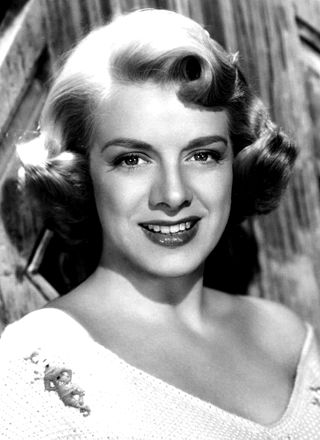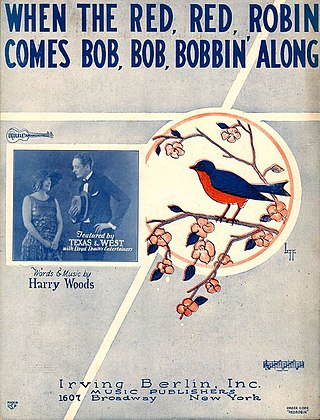Related Research Articles

Harry Lillis "Bing" Crosby Jr. was an American singer, actor, television producer, television and radio personality, and businessman. The first multimedia star, he was one of the most popular and influential musical artists of the 20th century worldwide. Crosby was a leader in record sales, network radio ratings, and motion picture grosses from 1926 to 1977. He was one of the first global cultural icons. Crosby made over 70 feature films and recorded more than 1,600 songs.

Rose M. Clooney was an American singer and actress. She came to prominence in the early 1950s with the song "Come On-a My House", which was followed by other pop numbers such as "Botch-a-Me", "Mambo Italiano", "Tenderly", "Half as Much", "Hey There", "This Ole House", and "Sway". She also had success as a jazz vocalist. Clooney's career languished in the 1960s, partly because of problems related to depression and drug addiction, but revived in 1977, when her White Christmas co-star Bing Crosby asked her to appear with him at a show marking his 50th anniversary in show business. She continued recording until her death in 2002.

Videotape is magnetic tape used for storing video and usually sound in addition. Information stored can be in the form of either an analog or digital signal. Videotape is used in both video tape recorders (VTRs) and, more commonly, videocassette recorders (VCRs) and camcorders. Videotapes have also been used for storing scientific or medical data, such as the data produced by an electrocardiogram.
The year 1956 in television involved some significant events. Below is a list of television-related events during 1956.

Ampex Data Systems Corporation is an American electronics company founded in 1944 by Alexander M. Poniatoff as a spin-off of Dalmo-Victor. The name AMPEX is an acronym, created by its founder, which stands for Alexander M. Poniatoff Excellence. Ampex operates as Ampex Data Systems Corporation, a subsidiary of Delta Information Systems, and consists of two business units. The Silicon Valley unit, known internally as Ampex Data Systems (ADS), manufactures digital data storage systems capable of functioning in harsh environments. The Colorado Springs, Colorado, unit, referred to as Ampex Intelligent Systems (AIS), serves as a laboratory and hub for the company's line of industrial control systems, cyber security products and services and its artificial intelligence/machine learning technology.

Arthur Godfrey's Talent Scouts was an American radio and television variety show which ran on CBS from 1946 until 1958. Sponsored by Lipton Tea, it starred Arthur Godfrey, who was also hosting Arthur Godfrey and His Friends at the same time.
Edwin LeMar "Buddy" Cole was a jazz pianist, organist, orchestra leader, and composer. He played behind a number of pop singers, including Rosemary Clooney and Bing Crosby.

2-inch quadruplex videotape was the first practical and commercially successful analog recording video tape format. It was developed and released for the broadcast television industry in 1956 by Ampex, an American company based in Redwood City, California. The first videotape recorder using this format was built the same year. This format revolutionized broadcast television operations and television production, since the only recording medium available to the TV industry until then was motion picture film.

Laurence Earl Crosby was the long-serving publicity director of his younger brother, Bing Crosby, a manager, a philanthropist, an inventor and an author. He was the eldest of Bing's six siblings.

Person to Person is a popular television program in the United States that originally ran from 1953 to 1961, with two episodes of an attempted revival airing in 2012. Edward R. Murrow hosted the original series from its inception in 1953 until 1959, interviewing celebrities in their homes from a comfortable chair in his New York studio. In the last two years of its original run, Charles Collingwood was the host.
William S. Morrow was a comedic screenwriter and producer who wrote scripts for radio, films and television.

The Frank Sinatra Show is an ABC variety and drama series, starring Frank Sinatra, premiering on October 18, 1957, and last airing on June 27, 1958.
"I've Got a Crush on You" is a song composed by George Gershwin, with lyrics by Ira Gershwin. It is unique among Gershwin compositions in that it was used for two different Broadway productions: Treasure Girl (1928), when it was introduced by Clifton Webb and Mary Hay, and Strike Up the Band (1930), when it was sung by Doris Carson and Gordon Smith. It was later included in the tribute musical Nice Work If You Can Get It (2012), in which it was sung by Jennifer Laura Thompson. When covered by Frank Sinatra he was a part of Columbia Records.
"We'll Be Together Again" is a 1945 popular song composed by Carl T. Fischer, with lyrics by Frankie Laine.

"When the Red, Red Robin " is a popular song written, both words and music, by Harry Woods in 1926. The song became the signature song for singer and actress Lillian Roth, who performed it often during the height of her musical career from the late 1920s to the late 1930s.

After Bing Crosby's long-term Decca Records contract was up, he signed many short-term contracts with a wide variety of labels. These included many popular labels such as Reprise, RCA, Verve, Decca (again), United Artists, Capitol and more.
The Bing Crosby – Rosemary Clooney Show commonly referred to as just The Crosby – Clooney Show was an American old-time talk radio program.
The Bing Crosby Show for General Electric was a 30-minute variety old-time radio program starring entertainer Bing Crosby. The series ran on CBS radio from 1952 to 1954. The series was sponsored by the General Electric company and was usually recorded in Hollywood, although some shows were recorded in Palm Springs. The last seven shows of the first season were broadcast as though they had come from Paris, France, but they had actually been recorded in the US prior to Crosby's departure for Europe.
The Ford Show Featuring Bing Crosby was a 5-minute CBS network radio show broadcast from 1957 to 1958. It included an opening theme, one or two songs by Bing Crosby, commercials by Ken Carpenter, closing theme, and on occasion a guest such as Rosemary Clooney.

A Christmas Sing with Bing was a series of transcribed radio hours hosted by Bing Crosby and broadcast on Christmas Eve for eight years from 1955 to 1962. The first edition of the program was released as an LP by Decca Records in 1956. Insurance Company of North America was the broadcast sponsor.
References
- ↑ "The Edsel Show" (website). On November 30, 1956, CBS played a delayed broadcast of Douglas Edwards and the News from New York to the Pacific Time Zone. Ampex Corporation, Ampex Chronology Archived 2007-07-03 at the Wayback Machine . On December 24, 1956, Arthur Godfrey's Talent Scouts , based in New York, became the first entertainment program to be videotaped for rebroadcast in the Pacific Time Zone. Val Adams, "C.B.S. Shows Off Tape-Recorded TV", The New York Times, December 21, 1956, p. 43. "TV Quietly Going to Tape Recording", Billboard , March 16, 1957, p. 3. On January 22, 1957, nine months before The Edsel Show, the NBC game show Truth or Consequences , produced in Hollywood, became the first program to be broadcast in all time zones from a prerecorded videotape. "Daily N.B.C. Show Will Be on Tape", The New York Times, January 18, 1957, p. 31.
- 1 2 Pairpoint, Lionel. "The Chronological Bing Crosby on Television". BING magazine. Retrieved February 18, 2016.
- ↑ "emmys.com". emmys.com. Retrieved February 18, 2016.
- 1 2 Macfarlane, Malcolm. "Bing Crosby - Day by Day". BING magazine. Retrieved February 18, 2016.
- ↑ Foreman, Joel (1997). The Other Fifties: Interrogating Midcentury American Icons. University of Illinois Press. p. 38. ISBN 0-252-06574-3.
- ↑ "On Television (1948-1977)". hymnsandcarolsofchristmas.com. Retrieved 24 October 2010.
- ↑ "Variety". October 16, 1957.
{{cite journal}}: Cite journal requires|journal=(help) - ↑ Clooney, Rosemary; Barthel, Joan (2001-10-09). Girl Singer: An Autobiography. Broadway. p. 161. ISBN 0-7679-0555-5.
